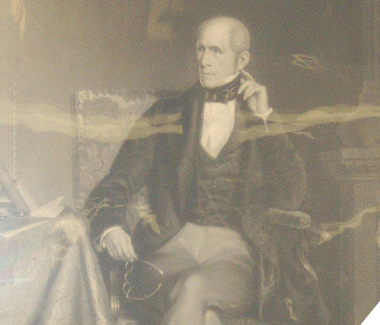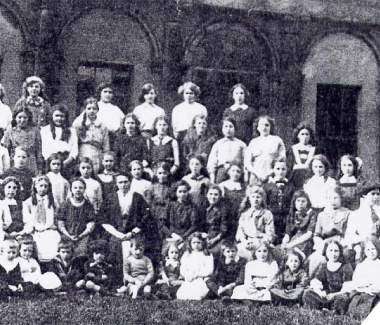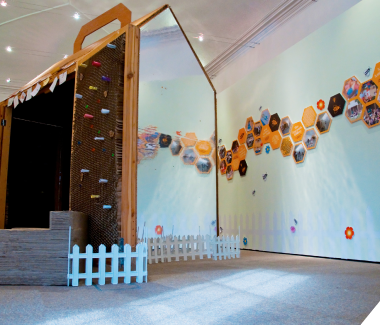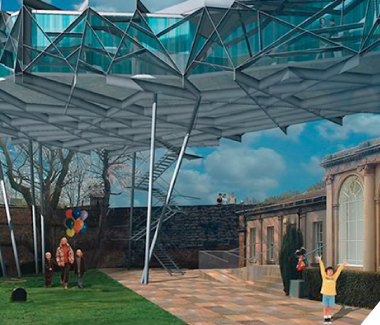“A garden building designed for the wintering of exotic shrubs and trees, primarily orange trees”
Historically an Orangery was a place for the cultivation of oranges and lemons and other exotic plants. These buildings were first introduced to Northern Europe in the 1700’s but did not start to become popular until 1800’s around the time the Wakefield Orangery was built. The surrounding gardens in which orange trees were placed were referred to as Orangeries ? although in time the term Orangery was used to describe the Orangery buildings themselves.
Only the wealthiest families, could afford the substantial cost of maintaining their collections of rare and unusual plants through cold Yorkshire winters. Orangeries were built with south facing glass windows to let in the maximum amount of afternoon sunlight. The northern wall of an Orangery was extremely thick, to protect against wind and cold.
To ensure the survival of sensitive plants in Northern European winters insulation was essential. Straw would often be used to insulate the roof and shutters put across the windows at night. On really cold days and nights coal braziers would be used to warm the Orangery.
The Orangery is today situated behind Wakefield’s Westgate Railway Station on Back Lane, though when it was built by Pemberton Milnes, a prosperous 18th century cloth merchant , there were no railways.
In the 1750’s Pemberton Milnes built himself a large town house, which still stands adjacent to the Station approach. According to Henry Clarkson a later occupant, the house was “rich in carving and plasterwork, after the designs of Gibbons.” However, since the house at that time was surrounded by rows of workman’s cottages, Milnes bought the land on the far side of Back Lane for his garden.
On Milne’s death in 1795 the town house and garden passed to his daughter Mary Milnes, the Dowager Vicountess of Galway, and it was she, a keen horticulturalist, who had the Orangery built probably in the late 1790s. Viscountess Galway spent the summer months at Bawtry Hall her home near Barnsley, but every year visited Wakefield and was known as a keen theatregoer. She died aged 81 on 15th November 1835. Like her mother and father she was buried in the catacombs below Westgate Chapel.
In July 1839 the Orangery was leased and opened on a commercial basis, as a Zoological gardens, complete with bear. Dancing bears were a popular attraction in the 1800s, and by the time the Zoological gardens opened at The Orangery, dancing bears were commonplace in streets all over Victorian England. The decision to add a bear to bring in the crowds at The Orangery however proved fatal and cost the keepers wife her life! She was mauled to death when the bear escaped. Following this incident the popularity of the gardens declined.
In 1849 The Orangery was sold to Daniel Gaskell, Wakefield’s first MP. He presented the gardens to the Trustees of Westgate Unitarian Chapel across the road in 1850, where both Pemberton Milnes and his daughter Viscountess Galway, had worshipped.
The congregation of the chapel had adopted Unitarian thought in the eighteenth century. Its members took a leading part in the economic, social, educational, political and spiritual life of Wakefield and its vicinity. Almost all those interred in its catacombs, perhaps the earliest in the country to be opened for public burials, are industrialists, innovators, merchant princes, members of Parliament and political radicals.
The Orangery was now used as a graveyard and many of the grave stones survive. The particularly fine monument in the gardens is for one of the early Chartists, Joseph Horner, a Wakefield corn miller who died 1850. The inscription says that the memorial was “erected by voluntary subscription 999 inhabitants of Wakefield neighbourhood” in memory of Horner’s “consistent advocacy of religious, moral, social and political rights and liberties for the people.
When the Orangery was presented to the Chapel it was Daniel Gaskell’s original intention that the building should be used as a non-denominational school for poor children, but the scheme met with little success, though the Sunday School did take up residence.
From time to time the building was let to private schools, George Gissing, the Wakefield born novelist was educated here. The last such tenancy was between the 1930s and 1957, when the premises were occupied by the Collegiate School, the kindergarten branch of the Wakefield Academy. Various photographs survive showing some of the former students who attended the Academy. There also seems to have been a tradition for amateur dramatics as the many programmes and photographs will testify.
The Orangery was purchased in 1996 by the charity Public Arts as office accommodation. Today Public Arts is known as Beam and the building is used as a gallery, education and conferencing centre and offices; providing a fantastic heritage setting for contemporary artwork, and innovative thinking on urban, architectural and built environment design.
Beam is dedicated to the imaginative understanding and improvement of the public realm, aiming to create better understanding about the importance of the arts and good design; to make stronger connections between professionals and the public; and to celebrate the arts and good design in places and spaces as a powerful contributor to personal, economic and community wellbeing.
Put simply Beam’s mission is ‘To help people make great places ? to live, work and play in’
The Westgate area of Wakefield is one of the most important city centre development sites in the region. It will provide an exciting opportunity to create a new and prosperous quarter in the city including development of Wakefield Westgate Railway Station and the former goods yard. Work is underway, with Phase 1 completed, with the master plan, like the arrival of the railway 150 years ago, making this part of Wakefield almost unrecognisable.
It is intended that the Station will move to a location to the north of the Orangery, to be replaced by a hotel and a new public park that will lie between Pemberton House and the Unitarian Chapel at the same level as Westgate itself. This will visually re-link the three historic buildings and open exciting new vistas both towards and from the Orangery. At the same time, a pedestrianised square will be created immediately to the north of the Orangery, where people arriving at the new railway station will behold an entire new quarter of Wakefield.
In 2003 beam commissioned internationally renowned architects SMC Alsop to produce designs for further development of the Orangery as a ‘Creative Centre for the Built Environment.” Alsop’s brief was to be imaginative, innovative, and inspiring; to double the available floor space for education, meetings, exhibitions and offices; and to respect and enhance access to the site’s unique heritage qualities. Alsop’s proposed solution is to leave the unique south side of the Orangery, with its graves and trees, virtually intact; add a glassed ground-floor extension to the rear (or north) side of the Orangery, as a caf? and gallery garden; and create a new ‘aerial pavilion’ for conferencing and educational use.
Planning permission has been given for the pavilion, which would be angled dynamically, floating high over the original building, and would meet the new station and Westgate development to the north and east. It would create a striking contemporary beacon for the ‘new’ Orangery and for Wakefield and the region.
Whilst the ambition to build something wonderful remains, in the current economic climate, Beam are now looking at alternative schemes. When Alsop designed his pavilion there was uncertainty about the details of developments around us, now these are more certain the new extension will seek to improve access from Westgate to the new station, and from both to The Orangery.








